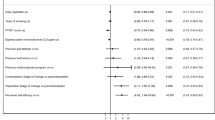Abstract
The objective of the study was to identify factors which predispose women to smoking relapse postpartum and the factors that prevent the relapse, in order to design effective interventions to reduce the rate of smoking relapse after delivery. A prospective cohort study was conducted in 2004 and 2005 in Lodz, Poland. One hundred thirty-eight women who quit smoking for the pregnancy period were enrolled into the study between 32 and 36 weeks of pregnancy and were followed up at 3 months after delivery. Self-reported non-smoking status at enrollment and postpartum was verified using saliva cotinine level analyzed by liquid chromatography with tandem mass spectrometry (LC–MS/MS). The cut-off point of 10 ng/ml was adopted for the saliva cotinine level. About half of the study population relapsed into smoking within 3 months after delivery. Most (49%) relapses occurred in the first 4 weeks postpartum. Three factors were identified as directly influencing smoking relapse after delivery: need to cope with stressful situations (OR = 4.7; 95% CI 1.7–14.3), type of quitting attempt (OR = 4.0; 95% CI 1.1–16.1), and smoking environment at home (OR = 7.2; 95% CI 2.2–28.3). These three factors accounted for 84.0% (95% CI 52.7–96.1) of relapses. The profile of women who relapse to smoking after delivery can be described as quitting smoking only for pregnancy and postpartum period, resorting to smoking in response to stressful situations, and living with smokers. Those factors should be taken into account while conducting antismoking intervention for pregnant and postpartum women.

Similar content being viewed by others
References
Mullen, P. D. (2004). How can more smoking suspension during pregnancy become lifelong abstinence? Lessons learned about predictors, interventions, and gaps in our accumulated knowledge. Nicotine & Tobacco Research, 6(2), 217–238.
Lumley, J., & Chamberlain, C., et al. (2009). Psychosocial interventions for promoting smoking cessation during pregnancy. Cochrane Database of Systematic Reviews 2009, Issue 3, Art. No: CD001055.
Mullen, P. D., Richardson, M. A., et al. (1997). Postpartum return to smoking: Who is at risk and when. American Journal of Health Promotion, 11(5), 323–330.
Colman, G. J., & Joyce, T. (2003). Trends in smoking before, during and after pregnancy in ten states. American Journal of Preventive Medicine, 24(1), 29–35.
Thyrian, J. R., Hannöve, W., et al. (2006). Postpartum return to smoking: Identifying different groups to tailor interventions. Addictive Behaviors, 31(10), 1785–1796.
Fang, W. L., Goldstein, A. O., et al. (2004). Smoking cessation in pregnancy: A review of postpartum relapse prevention strategies. The Journal of the American Board of Family Practice, 17(4), 264–275.
Secker-Walker, R. H., Salomon, L. J., et al. (1995). Smoking relapse prevention counseling during prenatal and early postnatal care. American Journal of Preventive Medicine, 11(2), 86–93.
McBride, C. M., Curry, S. J., et al. (1999). Prevention of relapse in women who quit smoking during pregnancy. American Journal of Public Health, 89(5), 706–711.
Petersen, L., Hajek, J., et al. (1992). Smoking reduction during pregnancy by a program of self-help and clinical support. Obstetric & Gynecology, 79(6), 924–930.
Solomon, L. J., Higgins, S. T., et al. (2007). Predictors of postpartum relapse to smoking. Drug and Alcohol Dependence, 90(2–3), 224–227.
Ma, Y., Goins, K. V., et al. (2005). Predictors of smoking cessation in pregnancy and maintenance postpartum in low-income women. Maternal and Child Health Journal, 9, 393–402.
SRNT Subcommittee on Biochemical Verification. (2004). Biochemical verification of tobacco use and cessation. Nicotine & Tobbaco Research, 6(5), 863–864.
StataCorp. (2003) Stata Statistical Software: Release 8.0. College Station, TX: Stata Corporation.
Spirtes, P., Glymour, C., & Scheines, R. (2001). Causation, prediction, and search (2nd ed.). New York, N.Y.: Springer/MIT Press.
Andrea Lehnert-Batar pARtial: pARtial package. R package version 0.1.2006.
Lelong, N., Kaminski, M., et al. (2001). Postpartum return to smoking among usual smokers who quit during pregnancy. European Journal of Public Health, 11, 334–339.
Severson, H. H., Andrews, J. A., et al. (1995). Predictors of smoking during and after pregnancy: A survey of mothers of newborns. Preventive Medicine, 24(1), 23–28.
Polańska, K., Hanke, W., et al. (2005). Smoking relapse one year after delivery among women who quit smoking during pregnancy. International Journal of Occupational Medicine and Environmental Health, 18(2), 159–165.
Acknowledgments
This project was supported by Fogarty International Center training grant No. 2 D43 TW00621-08 funded by the Fogarty International Center and the International Institute for Rural and Environmental Health.
Author information
Authors and Affiliations
Corresponding author
Rights and permissions
About this article
Cite this article
Polanska, K., Hanke, W., Sobala, W. et al. Predictors of Smoking Relapse After Delivery: Prospective Study in Central Poland. Matern Child Health J 15, 579–586 (2011). https://doi.org/10.1007/s10995-010-0639-y
Published:
Issue Date:
DOI: https://doi.org/10.1007/s10995-010-0639-y




